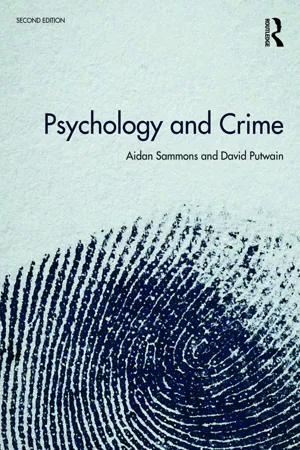Psychology
Genetic Explanations of Offending Behaviour
Genetic explanations of offending behavior suggest that genetic factors may contribute to an individual's likelihood of engaging in criminal or antisocial behavior. These explanations focus on the influence of genetic variations on traits such as impulsivity, aggression, and sensation-seeking, which are associated with criminal conduct. While genetic factors may play a role, they interact with environmental influences in complex ways.
Written by Perlego with AI-assistance
Related key terms
6 Key excerpts on "Genetic Explanations of Offending Behaviour"
- eBook - ePub
- John MacDonald(Author)
- 2017(Publication Date)
- Routledge(Publisher)
The most plausible view of genetic contributions to crime assumes that multiple genes are involved through their role in coding for enzymes and proteins that influence psychological processes that may make an individual more or less vulnerable to participation in antisocial behavior or crime. More recently, genetic contributions to complex behaviors have been conceptualized as being conditional on environmental risk factors, with epigenetic and gene expression studies challenging the idea that our genetic code is fixed. Within this framework, genes are not necessarily expected to exert a main effect on behavior but instead are assumed to create vulnerabilities that may be expressed if certain environmental conditions are present (see, e.g., work by Caspi et al., 2002). In addition, epigenetic research is providing compelling evidence that genes can be altered via environmental exposures (Meaney, 2010). This line of research has fundamentally changed our deterministic conceptualization of genes as fixed variables and raises the possibility that the expression of genes may vary across both context and development. These conceptual shifts in understanding genetic contributions to criminality have left researchers with the daunting task of disentangling how complex systems of genes interact with each other—and the environment—to influence behavior. Genes have now become moving and dynamic targets within social science research, where linear and additive models of influence are no longer sufficient prerequisites for building explanatory models. To this end, genetically informed research is rapidly moving away from the estimation of heritability coefficients and toward approaches that can help to isolate the role of specific genetic and environmental factors in antisocial behavior - eBook - ePub
Crime and Criminality
A multidisciplinary approach
- Sandie Taylor(Author)
- 2015(Publication Date)
- Routledge(Publisher)
16 ). Hence whilst biological psychologists have sought to help explain why some individuals turn to violent criminal behaviour through a greater understanding of genes, hormones and brain activity, evolutionary psychologists are now attempting to explain why the males of our species might be particularly susceptible to such patterns of response.Summary• There are many independent and interdependent biological factors that help to explain why some individuals resort to antisocial, violent and aggressive behaviour. These biological factors include genetics and chromosomes; bio-neurochemistry; brain studies, and evolution. Research looking into the influence of genes and chromosomes was considered using familial, twin and adoptee studies and in more detail from gene mutations such as MAOA and chromosome disorders such as XXY and XYY. Twin studies provide partial evidence of there being a genetic basis for criminal behaviour in terms of pairwise concordance and hereditability estimates. Such studies also provide evidence of a gene–environment relationship, the extent of which is difficult to determine conclusively.• Studies that have considered the behaviour of MZ twins separated at birth have helped us to understand the relative contributions of nature and nurture to criminality. Recent work on variations in genes (and chromosomes) between related individuals has helped to further this knowledge. By studying the lineage of criminal families, it is possible to locate how the propensity for violence for instance is passed on from father to son. Studies of adoptees have helped us to understand the influence of criminal biological and adoptive parents on criminality. Findings suggest that criminal biological parents have more influence on criminality than adoptive parents. There is a combined influence of biological and adoptive parents who are criminal on adoptees, therefore providing evidence of a gene–environment interaction on criminal behaviour. - eBook - ePub
- Ian Marsh(Author)
- 2007(Publication Date)
- Routledge(Publisher)
The debate over the importance of genes in behaviour has always been intense, from the eugenics movement at the start of the twentieth century right through to the present (e.g. Lewontin, Rose and Kamin 1984). Critics, some from within biology, have attacked the implication that genes largely determine our behaviour as well as the interpretation of the data from some of the methods that form the cornerstone of the genetic approach. For most of the twentieth century the ‘nature versus nurture’ debate, in which one side argued that biology, especially genes, determined our behaviour and the other that the environment determined how we behaved, was how disagreements were presented. More recently it has become clear that the evidence makes sense only if the biosocial interaction model is used (e.g. Raine 2002b).No serious biologists think that there is ‘a criminal gene’: they are looking for genes that make criminal behaviour more probable. If genes can influence our impulsivity, and we know impulsivity makes you more likely to become an offender, then those genes increase the probability that you will perform criminal acts.We now have compelling evidence that genes are important in establishing the likelihood that we will display particular anti-social and criminal behaviour. For example Brunner et al. (1991) showed that one defective version of a gene that makes an enzyme crucial in how some of our neurons work leads to a massively increased risk of very violent behaviour.As with evolution there are several distinct approaches within genetic research. We will consider two: behavioural genetics and molecular biology.The combination of sustained criticism and improved understanding has resulted in the recognition that the impact of genes depends on the social and physical environment that the person lives in. Investigating the contribution genes make to a behaviour also reveals the importance of the environment. Parens (2004) gives a clear account of our present understanding of the role of each and of the difficulties in interpreting the results from such studies.Behavioural genetics
Behavioural genetics tries to identify how important genes are in particular behaviours using methods that rely on comparing how similar different relatives are on that behaviour. Different relatives share different, predictable proportions of their genes. Humans share about 99 per cent of their genes because most are for crucial biological systems such as your heart, liver etc. Humans all need genes to do the same tasks, so we may all seem to have the same set of genes. However, remember that there will be a variety of versions of the same gene so we will end up with different genotypes. Almost all the genes we have do not appear to be relevant to how likely we are to be anti-social or criminal; that leaves a much smaller number where variations in the versions, or alleles that we inherit may alter our predisposition to criminality. If you share half of your alleles in general with a relative then you will also be likely to share half of those alleles relevant to criminal behaviour. - eBook - ePub
- Francis Pakes, Jane Winstone(Authors)
- 2013(Publication Date)
- Willan(Publisher)
These accounts illustrate that asking ‘why’ is not necessarily the right question. To understand offending behaviour so that we can predict or prevent it requires a different type of analysis. That is what this chapter is about. Before he became prime minister, Tony Blair launched a famous slogan when he said that New Labour would be ‘tough on crime, tough on the causes of crime’ (Blair 1993). In order to start our enquiry, we must develop ideas about what we actually mean when we talk about the causes of crime. After that, this chapter will outline various biological, psychological and social explanations of crime. Biological factors include genes, hormones, and brain injury or dysfunction. Psychological factors include personality, a factor known as self-control, and the concept of sensation seeking. We will also examine the role of the family. Sociological factors include poverty, subcultures and a concept called strain. In the end, we examine factors that might prevent people from committing crime.Understanding causes of crime
When psychologists or criminologists talk about offending behaviour, they are often talking about causes of crime rather than motives. We do not necessarily need to know what the offender was thinking at the time of the offence. It is anyway doubtful whether that is where reliable answers can be found. After all, we can only uncover that by asking the offender, and it is very possible that the answer will be influenced by demand characteristics (that is, the expectation of what the interviewer wants to hear) and concerns of self-presentation (that is, the desire to leave a particular impression of oneself); for example, Douglas and Olshaker (1997) argue that asking such questions often brings about well-rehearsed self-serving answers, rather than anything nearer to the truth.Instead, psychologists and criminologists are usually concerned with what the social and psychological factors are that contribute to the offending behaviour. Thus, when we talk about the causes of crime, psychologists and criminologists tend to look at general factors that apply to offending and offenders in a way that is disproportionate. If most offenders share a characteristic which non-offenders do not, that might be identified as a possible correlate of crime. Whether that characteristic is anything to do with actually producing crime is a different matter. That is a key question when deciding to call a factor a cause - eBook - ePub
- Matt Jarvis(Author)
- 2005(Publication Date)
- Routledge(Publisher)
8 Biological psychology 1: genetic influences on behaviour
Key assumptions of the approach Behavioural genetics: the genetics of individual differences Evolutionary psychology: the genetics of human similarity Contemporary issue: does behavioural genetics pose a threat to other psychological approaches? Contributions and limitations of genetically based approaches SummaryKey assumptions of the approach
Have you ever wondered why a particular characteristic like high IQ or perhaps a bad temper seems to run in your family? Thinking about people more generally, have you ever considered why people prefer to go to the toilet alone, or why a young man going out with an older woman raises eyebrows whereas no one looks twice at an older man partnered with a young woman? Although there are many possible explanations for these patterns, there has recently been an upsurge of interest in biological explanations for these and many other psychological phenomena. Over the next two chapters we shall look at three major concepts from biology that have proved useful in explaining human psychology—genetics, evolution and neurophysiology.Genetics is the study of inheritance, and has been applied to psychology in looking at the extent to which psychological characteristics are affected by inheritance from parents. Evolution - eBook - ePub
Psychology and Crime
2nd edition
- Aidan Sammons, David Putwain(Authors)
- 2018(Publication Date)
- Routledge(Publisher)
Genes are sequences of deoxyribonucleic acid (DNA) that transmit information from one generation to its offspring. A human being has around 20,000 genes (Ezkurdia et al., 2014), inherited from their parents and organised into 23 pairs of chromosomes. Together, they provide a ‘blueprint’ for the development of the individual. The majority of genes are shared by all humans but around 1% of them exist in different forms called alleles. These contribute to the differences between people, influencing physical traits such as eye colour and psychological and behavioural traits such as personality. Genes are relevant to crime because some of them influence the development of the nervous system. They may therefore be responsible for the differences in the brain that are associated with offending.The consensus among biopsychologists is that genes influence criminal behaviour. This view rests on evidence from family history studies, twin studies and adoption studies. A family history study is conducted in order to ascertain whether a specific trait (in this case, offending) runs in families. If it does, this provides evidence that genetic influence plays a role. Osborn and West (1979) report that 40% of the sons of criminal fathers go on to get a criminal record themselves, compared with only 13% of the sons of non-criminal fathers. Other studies report similar results (Cloninger et al., 1978; West, 1982). Although suggestive of a genetic influence on offending, these findings could also indicate an environmental influence: sons might acquire criminal tendencies through social learning or the correlation might be due to the influence of a third variable that affects both father and son such as social class, deprivation or poor education (see Chapter 5 ).This problem is avoided by the twin study methodology, because it eliminates the confounding effect of shared environmental influences, at least in principle. A twin study compares monozygotic (MZ; genetically identical) and dizygotic (DZ; non-identical) twin pairs. It rests on the assumption that, in both MZ and DZ twins, criminality is affected by environmental factors to the same extent, because both MZ and DZ twins develop in equivalent environments: they are born into the same family, at the same time, go to the same schools etc. If it is found that the MZ twins are more similar in their criminality than the DZ twins this must be due to their greater genetic similarity. The similarity between twins is expressed as a correlation or concordance. A 25% concordance means that 25% of the time both
Learn about this page
Index pages curate the most relevant extracts from our library of academic textbooks. They’ve been created using an in-house natural language model (NLM), each adding context and meaning to key research topics.





